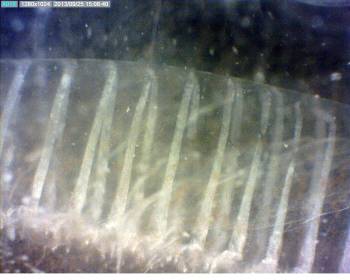Anatomy & Physiology
Pegea confoederata are cylindrical transparent organisms that are generally 5cm in length. This species of salp has a reduced musculature, where there are four main circular muscles and the first two are touching. No muscles extend past the dorsal part of the salp (Thompson 1948).
Digestive System
Salps are indiscriminate filter feeders that use a self-made mucous filter to catch particles passing through the body (see Feeding for more information). The mucous filter is continuously re-ingested and a new one is made and put into use. Re-ingestion of the mucous filter means that this is also digested and used for energy. The mucous filter is a carbon-rich structure, where as many of the food sources that salps ingest are more nitrogen-rich (Phillips et al. 2009). However, faecal matter maintains a high carbon concentration due to the mucous filter (Phillips et al. 2009).
|
|
|
|
Adult Pegea confoederata heart, displaying reversal of heart pumping.
(video by Helen Twaddle, Heron Island)
|
Circulation
|
|
|
|
Adult Pegea xonfoederata heart, pumping.
(video by Helen Twaddle, Heron Island)
|
While many invertebrate species that are in the same size range as Pegea confoederata rely solely on musculature to pump oxygenated blood around the body, as chordates, this species has a fully functional heart. Interestingly, all salps have a heart that reverses its flow every few minutes (Heron 1975). Heron (1975) suggests that this heart reversal could be due to the high metabolic rate of salps, and that oxygen content of the blood is a lot lower just prior to returning to the heart. Therefore, it makes sense for the salp to reverse its flow so that each organ receives sufficient oxygen and it can keep up the high metabolic and growth rates. Due to the transparency of salps, the heart can be seen beating without having to cut the animal up.
Respiration
Pegea confoederata have a mid-dorsal gill bar that can take in oxygen from the water that is pumped through the body. This gill bar separates the pharynx from the atrium (Ruppert et al. 2004). As salps are highly transparent, the gill bar is entirely obvious from the external part of the organism.

|
|
|
Gill bar of adult Pegea Confoederata
(photo by Helen Twaddle, Heron Island)
|
Nervous system
Salps have a brain that controls movements in the body. It has been shown that the brain possesses the ability to change normal muscle contractions depending on the external surroundings (Anderson et al. 1979). Please go to Sensory Systems to learn more about sensory parts of the nervous system.
|